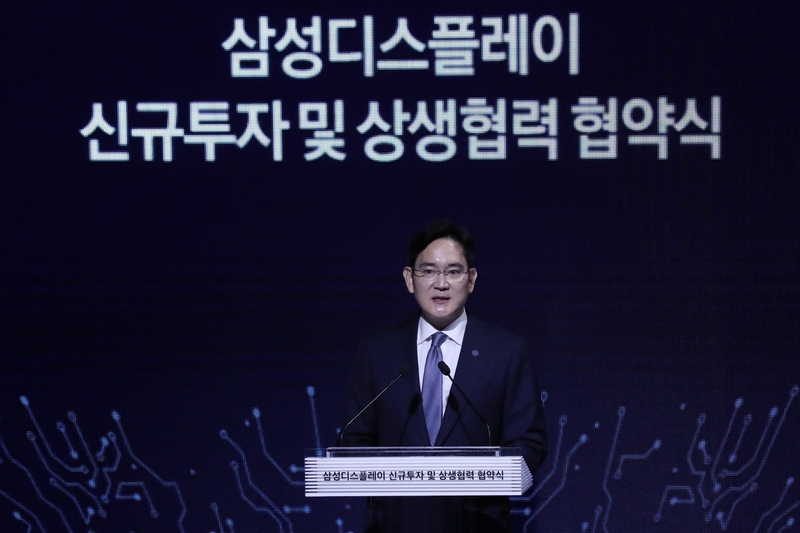 |
|
Samsung Electronics Vice Chairman Lee Jae-yong announces a new investment plan at a Samsung Display factory in Asan, South Chungcheong Province, on Oct. 10. (Kim Jung-hyo, staff photographer)
|
Company to convert LCD panel production into large-scale “QD display” line
On Oct. 10, Samsung Electronics affiliate Samsung Display announced plans for 13.1 trillion won (US$11.04 billion) in investments through 2025. Its aim is to convert the large-scale LCD panel production line at its Tangjeong plant in Asan, South Chungcheong Province, into a large-scale OLED line. Amid an intensifying onslaught from Chinese “budget” LCDs, the company is belatedly venturing into the large OLED market previously monopolized by LG Display. Currently leading the global market with TVs that apply quantum dot (QD) technology to LCD, Samsung Electronics appears to be gearing up to release a QD OLED TV with the shift in its affiliate’s strategy. One noteworthy aspect of the latest announcement is that the investment plan included no mention of the term “OLED.” Indeed, the company even requested that the term “display” be used instead of “OLED.” Even though its plan is to produce a “QD-OLED” TV, Samsung asked for it to be referred to a “QD display” for the time being. “Since there are going to be other forms of technology using QD besides OLED, we can’t restrict it to OLED,” said a Samsung Display spokesperson. Yet as recently as last month, an announcement about “QD OLED” was up in the Samsung Display newsroom, with an explanation describing it as “a method combining quantum dots and OLED.” It has since been deleted. The same image in the latest investment announcement was presented without the term “OLED.” But Samsung actually has its reasons for going to such lengths to avoid it. Unlike LCD panels, OLED panels contain organic substances that produce light on their own, which means they require no backlighting. Because of this property, they are able to render the color black well and can be made thin and rollable. The brand name “OLED” is used by LG Electronics, which previously commercialized OLED TVs and plans to release the first rollable TV toward the end of this year. OLED has yet to dominate the TV market, with LCD accounting for 98.9% of TV market volume in 2018. But its share is growing, and units sell for high prices on the premium market. Samsung Electronics actually missed out narrowly on the opportunity to be first to release an OLED TV. In 2012, it presented the Samsung OLED TV, with a 55-inch OLED panel provided by Samsung Display. It was promoted as the “world’s first OLED TV.” But production was halted just as mass production was set to begin. The conclusion was that the yield value (percentage of finished items) was too low to break even. Soon afterwards, LG Electronics suddenly released its own OLED TV and took the lead in the “OLED TV” campaign. LG Display now has a monopoly on large OLED panel supplies, with LG Electronics maintaining a 62.2% share of the OLED TV market. In contrast, Samsung Electronics has taken its changes with a “QLED TV” combining QD technology with LCDs. “I can’t say we’re not doing a large OLED TV, but I wouldn’t say that’s necessarily the road for us either,” said CEO Kim Hyun-suk, then the director of the Samsung Electronics video display project division, in May 2016. His remarks seem to shrug off the possibility of resuming production. Kim also said, “I can’t say that large OLED will be central to our displays.” He now oversees consumer electronics (CE) as CEO at Samsung Electronics. Samsung Electronics also said a number of things amid its aggressive criticisms of OLED displays during the years of competition between LG Electronics’ OLED TVs and its own QLED TV. For it to talk now about the superiority of OLED puts it something a self-contradictory position. Samsung Electronics Vice Chairman Yoon Book-keun was asked about this while meeting with reporters on Oct. 15 at a 2019 Samsung partner company job fair at COEX in Seoul’s Gangnam District. Remarking on the omission of the term “OLED” from the name of Samsung’s “QD display,” Yoon said, “I don’t see it as all that important.” “The important thing is offering the highest level of picture quality to the consumer,” he said. Samsung has announced plans to begin production of QD OLED televisions – oops, “QD displays” – of 65 inches and larger by 2021. It appears likely to focus on highlighting the difference in technology with its blue OLED (B-OLED) using QD color filters, unlike LG Display’s white OLED (W-OLED). What does Samsung plan to call its large OLED product once it reaches the commercialization stage? Samsung Electronics’ QLED “keyword” is currently the focus of an investigation by the Fair Trade Commission (FT) after a complaint by LG Electronics, which claimed Samsung is “misleadingly presenting LCD to consumers as OLED.” The issue here concerns the use of an identical label to “quantum light-emitting diode” (QLED), a nascent technology that is still in its developmental phase. The outcome of the FTC investigation also appears likely to have an impact on the future name of Samsung’s OLED product. By Song Gyung-hwa, staff reporter Please direct comments or questions to [english@hani.co.kr]






